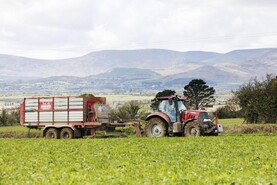Excellent drying conditions over the course of last weekend has provided the perfect opportunity to get yearling dairy-beef stock back out to grass.
The first 120 days at grass is always the best of the year, and so farmers need to make the most of the decent weather conditions currently being experienced.
Where little or no grazing has taken place on farm up to this point the decision needs to be made whether to graze silage ground or not before closing.
Where grass covers are high on silage ground and it hasn’t been grazed since last autumn, the preference would be to clean it off prior to closing.
This will help improve the overall quality of the silage crop by as much as 5%DMD. This is because it removes the dead or decaying older grass at the bottom of the sward which, if cut for silage would reduce the overall feed value.
However, this should only be done if you can get across the silage ground in the next fortnight prior to closing. On dairy-beef farms, having enough grazing pressure in early spring can be difficult as the heaviest yearlings are only 370kg.
This can result in too much time spent grazing the silage ground while grass on the grazing block goes ahead of stock. Striking the balance can be difficult.
Maximise growth rates
Once onto the grazing block with stock, try to target a pre-grazing sward height of 10cm to 12cm. If you can do this on a consistent basis, you will see the benefit in terms of daily live weight gains.
In order to do so, stock need to be moving to fresh grass every two to three days. Therefore, the allocation of ground needs to be correct in order to get ground grazed off in the allotted time period.
Spending too long in large paddocks will slow down the grazing rotation, hit grass regrowths which will reduce the total amount of grass grown over the entire season and reduce live weight gain at pasture.
Walk the farm
While very few beef farms are measuring grass, the minimum requirement should be to at least walk the farm once a week to get a better handle on the amount of grass building ahead of you.
Weigh stock
Farmers turning stock out to grass in the coming days should weigh cattle now, and again in mid-May to see how they have performed over this period.
While you will be able to judge how well stock have performed, it is better and more satisfactory to be able to put a figure on it so that you have a benchmark to improve and work on in the future.






 This is a subscriber-only article
This is a subscriber-only article











SHARING OPTIONS: